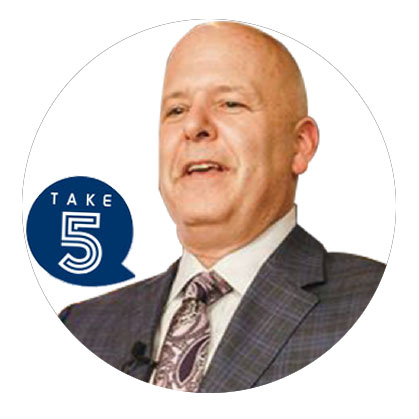Christine Comaford


A well-told story engages more parts of the brain than listening to straight facts. Company values its mission even meetings can all be stories — why you’re working together where you are trying to go
C hristine Comaford Founder and CEO of SmartTribes Institute is a neuroscience-based executive coach. Using knowledge of the workings of the brain she helps leaders capitalize on growth and change within their companies.
Here she shares five insights with radio personality and marketing expert Yitzchok Saftlas for businesses seeking to grow and thrive.
State of Mind
Choosing your response to change — rather than reacting instinctively — is smarter and more productive. “Human beings are very emotional creatures” claims Ms. Comaford. “We think we are these intellectual powerhouses but what’s really driving the boat if you will is our emotional brain.” According to Comaford a full 90 percent of decisions are dominated by the emotional brain — which means they’re not always well thought-out.
When we feel threatened by change our first instinct is to react compulsively in what Comaford calls “critter state.” This fight/flight/freeze response doesn’t involve complex thought just survival. In critter state we respond with anger frustration getting upset — essentially nothing productive. Instead we need to move into our “smart state ” where decisions originate in the higher brain where we think abstractly plan and resolve complex issues.
One way to make that switch? Change the meaning you give to a situation explains Comaford.
Say you just got tons of new client orders. You can be totally overwhelmed and stressed out which pulls you into “critter state” dragging everyone else down with you. But if you change the meaning you assign to it reframing the situation — “Isn’t this awesome to provide so much value to have so many clients” — you’ll get to your “smart state.”
Tell Your Story
To get employees truly invested you need to engage their emotions. That said emotions have their place in workplaces and it’s not secondary.
“Work needs to be meaningful” says Christine. “Otherwise it’s drudgery — the heart’s not in it you’re not emotionally engaged.”
Emotional engagement she says is the foundation for innovation and performance — which is what leaders want from their teams.
That’s why the best leaders are also great storytellers says Comaford. When hearing a story you relate to the characters and feel what they’re feeling. You also mirror the posture and gestures of the speaker becoming more like him. As you listen the brain releases the neurotransmitter dopamine making it easier to remember and with greater accuracy.
A well-told story engages more parts of the brain than listening to straight facts. Company values its mission even meetings can all be stories — why you’re working together where you are trying to go.
“Stories are a great way to rally the team… and to engage your customers” says Comaford. The more emotionally engaging your company’s story the more the employee or customer will remember it.
Member of the Tribe
Build loyalty and improve performance by creating a “tribal” atmosphere. It’s no accident that Christine Comaford calls her institute SmartTribes. “Tribes are so primal” she describes. “They evoke these images of people gathered around the fire people who need each other to get ahead.”
Building a similar atmosphere in your company works to your benefit. People want to belong somewhere to matter Comaford emphasizes. When a company focuses on those needs it engages people in the business and makes them want to perform.
It becomes “something bigger than just us” Comaford continues. “It’s about the welfare of the tribe about having status within the tribe.”
That’s why she advises recognizing employees for their achievements in a public and very specific way: “High five to Yitzchok for modeling our value of accountability. He got such-and-such project done on time and on budget. We knew it was going to be a challenge and he did it.” This allows Yitzchok to stand a little taller and also shows the rest of the company that their achievements matter.
Make Meetings Count
Meetings can be productive and efficient with a few smart tweaks.
“People hate meetings because they are usually a waste of time” asserts Comaford. Most meetings focus on sharing information — which people can review on their own time — or “point-proving.” Yes meetings often involve debating the right course of action and making decisions usually with everyone sharing their opinions. While valuable this takes a lot of time and doesn’t get you to what you really need from a meeting: requests and promises.

"Can you take care of this task?”
“Yes I will get it done by Monday.”
Comaford has a variety of suggestions for making meetings more effective so “people start to love meetings!” For instance to manage communication she recommends passing out three colors of index cards. Holding up a white card signals “I want to talk next.” A pink card means “I disagree ” while a green card lets attendees know “I agree; this works for me.”
“People like to chime in” she says. “This makes them feel heard.”
Comaford also stresses the importance of timeliness suggesting calling the meeting five minutes before your ideal start time and penalizing lateness. “A lot of our clients say $20 if you’re five minutes late $50 if you’re six to ten minutes late. Pretty quickly people show up on time.”
Live Up to Your Role
Leadership is a privilege not an entitlement. Many leaders see their work as a burden or worse — as though they’re doing employees a favor by giving them a job. Comaford says the opposite is actually true.
“Leadership is the opportunity to cultivate and elevate others” she states. She encourages leaders to look at their position as an opportunity to be of service to people especially as it relates to the SBM of their employees. “It’s not about them serving you — hate to tell you — it’s about you standing over there and giving them what they need so they can move forward… If we sign up for this let’s show up for it.”
The three things humans really crave can be summarized by the acronym SBM: safety (for someone to have their back) belonging (to be connected to others) and mattering (to be acknowledged and appreciated). If the boss wants to boost performance or innovation she first needs to make sure her workers’ SBM needs are being fulfilled. That’s the key for getting workers emotionally engaged in the company.
Making that effort is worth it according to Christine who has also been a hospice volunteer for 17 years. What has she taken away from this experience? “The legacy we leave is the experience people have of us in their hearts. That’s what you’re creating.
“As you help people grow they will remember you their whole life.”
Oops! We could not locate your form.






